Burhan’s killing provided trigger to creeping unrest after PDP’s ideologically dubious alliance with BJP and steady radicalisation of youth
When a small team of the Special Operations Group of the J&K police and troops of 19 Rashtriya Rifles (RR) was pumping the last bullet into Burhan Muzaffar Wani in his hideout at Bumdoora village in south Kashmir, little did they know that their act would plunge Kashmir into yet another vicious cycle of death and destruction. There were impromptu celebrations in the camps of counterinsurgency forces over the killing of this 22-year-old Hizbul Mujahideen militant who had been challenging them with his bold social media presence. They didn’t realise that Kashmir was about to erupt in rage.
Burhan was killed in a neat operation: troops tracked him down on a tip-off with precise information, and it seems Burhan and two of his accomplices didn’t offer much resistance. “The encounter lasted three minutes,” said a senior JK police officer privy to the details of the action in the wee hours of July 8. With a dismissive smile, he added that Burhan was no great warrior but an irritant and a motivator who had managed to lure about 100 of the Facebook generation Kashmiris into insurgency. However, going by the folklore in Kashmir, Burhan was unconscious – probably poisoned – at the time of encounter. Another story says Burhan was captured alive and killed in cold blood for reward money of Rs 10 lakh that he carried on his head.
And as always, it’s difficult to sift facts from propaganda in Kashmir.
Soon after the Bumdoora operation, the networks of militants went into an overdrive to spread the news. The same night, two truckloads of masked youth had reached that picturesque village in the Pir Panjal foothills, brandishing axes and steel rods. They swooped down on the sprawling apple orchard of Khurram Mir, who had returned from the US and taken up a mission to boost Kashmir’s apple production. They chopped and uprooted some 7,000 trees that had been grafted with a high-yielding hybrid apple variety and set on fire two cottages where his employees lived. Nobody knows for sure if the absentee orchard owner had a role in Burhan’s death and it appeared more of mob revenge at the behest of Mir’s relatively poor neighbours, from whom he had purchased 6.25 acres of land for the orchard.
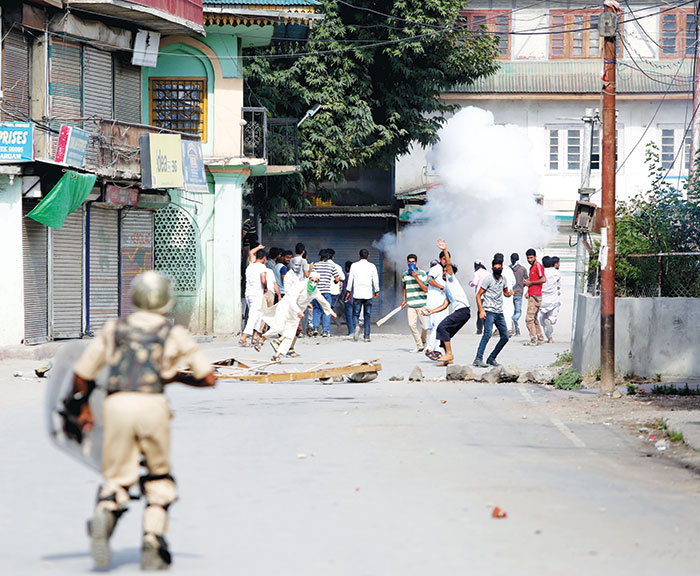
Angry youth clashing with security forces in Natipora area of Srinagar
Mir is a resourceful entrepreneur with multiple businesses, including cold storages in the Lassipora industrial area of Pulwama. His orchard at Bumdoora was an agricultural enterprise where he had planted a new hybrid of a local apple variety and a Bulgarian one developed by the Sher-e-Kashmir agriculture university in Srinagar. His aim was to increase the apple yield by six times. His project was expected to revolutionise apple farming in Kashmir. However, the vandalism meant that Mir had to take the first flight out of India – to the US – from where he had returned to Kashmir for the love of his land.
A close business associate of Mir told Governance Now in Srinagar that Mir had no clue to what had happened at Bumdoora since he had never lived there. “After what happened to Mir, I wonder if anyone would even think of investing in Kashmir. And if anyone does I would call him a mad man,” said one of his friends, who asked not to be named because he could become the target of militants’ ire.
In the meantime, most of Kashmir had shut down. Srinagar, the seat of the Mehbooba Mufti government in summer, quickly went into a civil curfew – a term coined by Kashmiris to describe voluntary shutdown-mode. Shopkeepers downed shutters, vehicles went off the roads, schools and colleges closed down fearing violence and office-goers looked forward to yet another round of paid holidays. Wary of violence and unrest the government too declared curfew in downtown Srinagar, an area which is most prone to anti-India demonstrations. Mehbooba obviously wanted to circumscribe the trouble spots and minimise casualties.
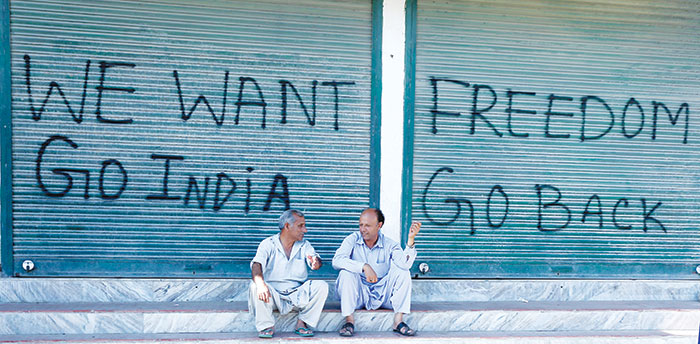
Burhan, the trigger
Burhan’s funeral at his Tral village on July 9 saw a mammoth participation, and mourners also included militants who wore masks, brandished guns and vowed revenge. However, it didn’t surprise anyone since over the years such funeral processions of militants had become common, particularly in south Kashmir. But going by the reaction of politicians and security officials, it is clear that Burhan was a chance catch and the government was unprepared to deal with the expected aftermath of his killing.
For example, when Burhan was killed, police chief K Rajendra was in Hyderabad for his daughter’s wedding. Rajendra was on a 10-day leave and yet he had not given charge to his second-in-command, SK Mishra, special director general (coordination, headquarters). So, it fell on the local police to deal with the aftermath of Burhan’s death, and they treated it like a routine affair in the absence of any special instructions from the top. No wonder, “most casualties occurred in these first two days,” said Naeem Akhtar, a close aide of the chief minister and the state’s education minister.
READ INTERVIEW WITH NAEEM AKHTAR: “Mehbooba has emerged as a very strong person in the crisis”
Another top functionary of the state government claimed that had police been sure that Burhan was present at the hideout, the government would have preferred to catch him alive. “A captured Burhan would have been like a mouse but a dead Burhan is deadly,” he said.
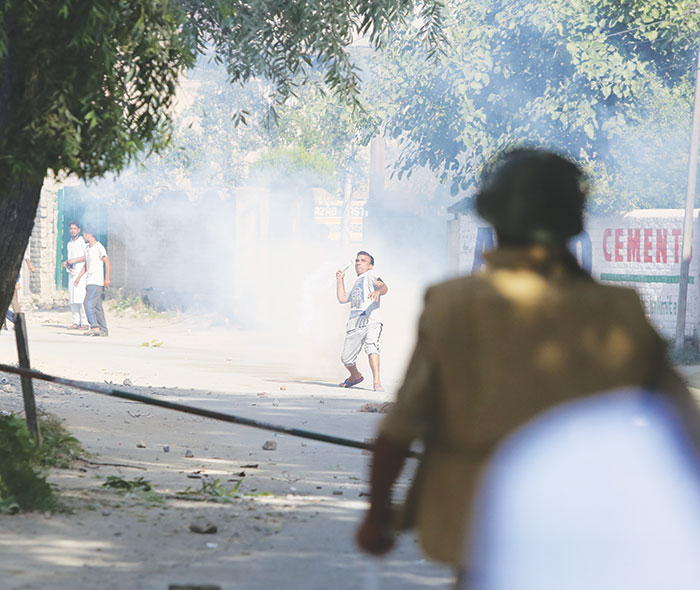
Mehbooba’s government was rattled by the scale and nature of violence in south Kashmir’s towns and villages. Mobs, at times led by armed militants, were attacking security forces and police stations in Pulwama, Anantnag, Kulgam and Shopian districts. “The attacks happened in remote areas on fringes of south Kashmir as against our expectations and preparedness in big population centres like Anantnag town and Srinagar. This was contrary to our thinking,” admitted a senior JK police officer.
Angry mobs of young men were moving from one village to another seeking to run over CRPF and army camps, air force station and police stations. Police opened fire and at places used pellet guns to keep mobs at bay. In Damhal Hanjipora, a remote village, the mob set fire to the newly built police station. As the officer in charge and others fled for their lives, the mob made good with a cache of assault rifles. Sakina Itoo, a former MLA from the main opposition National Conference, told Governance Now that her area had never seen any presence of militants. “Police should find out who were actually involved in attacking the new police station and looting arms,” Itoo said in reply to the ruling PDP’s allegations that her party men were involved in the episode.
“There was no chance for the security men to follow SOPs [standard operating procedures] on firing pellet guns as there was a real possibility of the camps being run over,” a senior police officer said. Pellets, which are iron balls sprayed with a gun to deter mobs from advancing, hit young protesters as well as bystanders hard, injuring their faces and eyes. The pellet gun, introduced in 2010 as a less brutal alternative to the regular gun, was never used so ruthlessly as this time, leaving many of its victims including women and children blind. According to Hurriyat leader Mirwiaz Umar Farooq, at least 15 victims have lost their eyesight so far.
READ INTERVIEW WITH MIRWAIZ UMAR FAROOQ: “The reality is that the Valley is up in arms against India”
The scale of violent protests could be gauged by the casualties suffered by security forces – some 3,000 men of CRPF and the JK police are injured while two policemen died in mob attacks in one month. So far 55 civilians have died while hundreds are being treated for pellet injuries in hospitals across Kashmir and in AIIMS, New Delhi.
The images of the injured and the dead added fuel to the fire. Mobs took control of highways and attacked private vehicles. Pilgrims coming from all over India to the Amarnath shrine had to be taken in army convoys at night to Sonmarg, for the alternative route to the holy cave of Lord Shiva. Soon the rush of pilgrims and tourists came down to a trickle, bringing the tourism industry to yet another deadend. Politicians and visiting journalists were confined to Srinagar as they faced the threat from marauding mobs who had set fire to vehicles on the highways. The situation had the trappings of a chaos that could bring down a government anywhere else in the world. However, in Kashmir, which has seen worse scenarios of public defiance and violence since 1989 when the armed insurgency began, things perhaps work differently.
At one time Mehbooba’s government looked vulnerable to public anger and was also under siege from within as many of the ruling party MLAs were openly blaming the government for deaths and injuries. One of its MLAs even termed Burhan Wani a ‘saint’. Initially Mehbooba showed her annoyance at the turn of events as she asked people to stop their children from throwing stones at security forces. She even blamed political leaders for stoking fires in Kashmir who had sent their children out of the Valley to study and work. But soon, she regained her composure and realised the folly of speaking the truth in Kashmir. She chose to keep herself out of the media’s reach and entrusted that job to her soft-spoken yet articulate education minister Naeem Akhtar. Next, she cracked the whip and asked all her party leaders to stop commenting on the situation and ordered house arrest of all the potential trouble-makers – leaders close to militants, like those of the Hurriyat Conference. Next, she plunged herself in work. “Bajji [sister in Urdu] leaves for the secretariat in the morning and takes meetings of officers all through the day. At the end of the day she meets all the security heads to discuss the situation,” a close aide of Mehbooba told Governance Now. Her instructions to the officers are to ensure supply of essential commodities across Kashmir. One day she flew down to Anantnag where she met families of the victims of violence in a dak bungalow.
Genesis of violence
Surely this is not an unprecedented situation in Kashmir as the Valley has seen worse forms of civil disobedience and violene recently – in 2008 and 2010. “We have passed through many tunnels and this time will also pass,” said Naeem Akhtar.
However, the current violence has thrown up new causes and manifestations of public anger, some of which is worrying for the future of Kashmir.
The popular analysis is that the anger in Kashmir is against the coming together of the PDP and the BJP for government formation after the 2014 elections had thrown up a hung assembly. “Mehbooba Mufti had campaigned mainly against BJP in the assembly elections, virtually cautioning Kashmiri Muslims against the rise of Narendra Modi as a Hindutva icon,” said a senior political leader, again, not willing to be named as he feared militants could harm his party men and relatives in south Kashmir.
He said during the poll campaign Mehbooba had created a fear psychosis among Muslims, indicating that if they vote for the National Conference which in the past had been part of the BJP-led NDA government at the centre, it would invite a Hindu tsunami on Kashmir. “Now when the PDP and BJP joined hands, her party men and youth in particular are angry and feel cheated,” said Omar Abdullah, the NC leader and former chief minister.
READ INTERVIEW WITH OMAR ABDULLAH: “We had warned against this unnatural alliance”
The BJP has no presence in Kashmir to mount any threat to rival political parties. However, as a senior PDP leader put it, Kashmiris have been feeling threatened by the perceived Hindutva agenda of the BJP-led government – like the beef ban, threats to abrogate Article 370 that gives special status to J&K, objection by some BJP leaders to the use of the state flag of J&K, talks about setting up Sainik Colonies in Kashmir and the planned return of Kashmiri Pandits. “A typical Kashmiri Musalmaan is happy eating his wazwan, doing embroidery, making wood and metal carved artefacts and living life at an easy pace. However, he gets disturbed whenever he feels that someone is trying to dilute his identity by trying to touch upon Article 370 or the state subject [residentship] laws,” said a senior PDP minister, explaining the anger of a common Kashmiri.
Religious indoctrination
However, those looking at Kashmir as part of a global Islamic resurgence say that blaming Mehbooba for the tie-up with BJP was a superficial explanation and a red herring to divert attention from the real cause. For long, the governments in Kashmir have tended to ignore the issue of religious radicalisation of young Kashmiris. “Has any government done a study on the number of private schools, institutions and colleges that have suddenly cropped up in the Valley,” asks an opposition legislator from south Kashmir. He says Kashmir is flush with money coming from international organisations which are into spreading radical Islam of the kind espoused by the Ahle Hadees. “No government has even tried to at least find out who run these colleges and institutions and what is being taught there.” He says on the ground Jamaat-e-Islami, which brands itself as a socio-religious organisation, is involved in large-scale religious indoctrination of Kashmiri youth and its members double up as over-ground workers for the militant organisations.
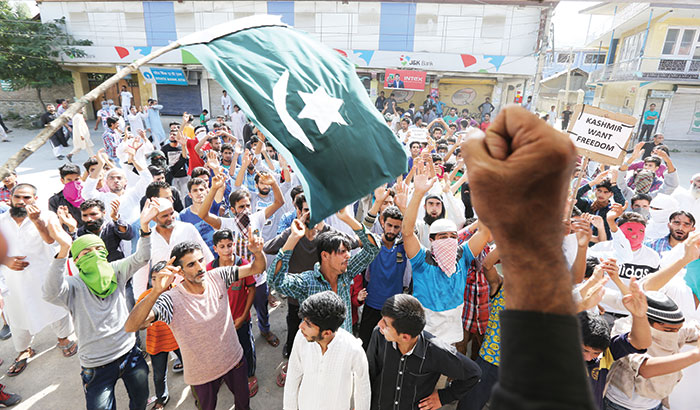
In the initial years of militancy, the Jamaat had openly functioned as a well-knit over ground support system for the once most powerful militants group, Hizbul Mujahideen. However, later its members were at the receiving end of the army supported by counter-insurgent groups like Ikhwaan-ul-Musalmeen headed by Kukka Parrey. This had battered Hizb and the Jamaat had soon dissociated itself from the azadi movement.
“While Jamaat was keeping a low profile, nobody noticed that the organisation was radicalising youth in schools, colleges and new-age Islamic institutions that had sprung up even in the remotest villages and hamlets of Kashmir,” says the legislator from south Kashmir.
He alleges that many articulate Jamaat members had been cultivating army and police authorities to the extent that they don’t even look at the threat posed by the group’s role in radicalisation of the Kashmiri youth. “The state and the security forces are only focused on killing an armed militant and have no policy to check the hate being put in the minds of young people,” he said. The radicalised youth, he claims, have made several “bulges” – a local term for flash protests – since 2010 to spread the anti-India sentiment across Kashmir.
Historically, south Kashmir has not only been a bastion of Mehbooba’s PDP but also of the Jamaat-e-Islami and the general perception in Kashmir is that the two have enjoyed a cosy relationship in the past. In fact, Mehbooba’s father Mufti Mohammad Sayeed was close to the Jamaat and the PDP had always banked on Jamaat’s tacit support in the elections. However, of late, the Jamaat had turned hostile to PDP and was openly supporting militancy. This is yet another explanation for the ongoing violent protests and the return of militancy to south Kashmir.
Giving his perspective on the ground situation in Kashmir, a senior police officer said that the Hizbul Mujahideen had got a fresh lease of life after the hanging of parliament attack convict Afzal Guru in Tihar jail of Delhi in 2013. “The group revived itself and started making fresh recruitments and recycling militants released from jail. The unrest in Kashmir had been growing over several months, manifesting in reactions to the beef controversy, clashes between local and other students at Srinagar’s NIT, protests over shelter homes for Kashmiri pandits and so on.” He said Burhan’s killing provided a perfect trigger for the Hizbul Mujahideen to show their strength.
Pakistan, on the other hand, had continued sending the Lashkar-e-Toiba militants to Kashmir to boost the morale of local militants. “Pakistan never changed its strategy. However, suddenly after Nawaz Sharif’s name cropped up in the Panama Papers [leaks of tax-evasive money parking], his position [in Pakistan] weakened and Islamabad is again getting aggressive on Kashmir,” he said.
Role of Politicians
The unrest in south Kashmir had also brought under focus another serious dimension of the Kashmir problem – the fragility of the political system. As mobs went on rampage, politicians remained huddled in Srinagar’s high-security bungalows. Most of them tried playing to the gallery by praising Burhan Wani and pandering to his admirers. Others decided to keep mum and not take sides. A senior BJP leader told Governance Now that he was sickened by the tacit support of PDP ministers for Burhan Wani’s role. “They are sitting in secure homes in Srinagar, have given themselves a three-fold raise in their salaries and each one has a retinue of six cars provided by the taxpayers’ money. If this posturing continues, we should rethink the alliance with PDP.”
Most of the leaders who speak candidly requested not to name them since their supporters and relatives could face reprisal from militants. Also they were alarmed by the irreverence shown by people and agitating youth towards the All Parties Hurriyat Conference. “This time the mobs are ignoring the Hurriyat’s calendar of protests. So nobody is in command, which is a worrying situation,” said a minister. “The attempt is to make political leaders of all shades irrelevant and let the mobs take control and that should worry us.”
Sources said a delegation of traders, cement dealers, transporters and fruit growers had met the hard-line pro-Pakistan ideologue Syed Ali Shah Geelani in Srinagar and urged him to make an appeal to end the ‘civil curfew’ since it was affecting trade and commerce. Geelani, it seems, expressed his helplessness. Sources said some militants had even warned Geelani against playing a peacemaker this time. They accused him of betrayal in 2010 when he had issued an appeal to end stone pelting in which 120 people had died.
At places dramatic scenes were witnessed as protests turned into impromptu rallies. According to local media, at one place a militant who wore a mask to hide his face, broke down when he asked people not to betray young people like him by lifting the civil curfew till azadi was achieved. The mob raised hands in support.
In downtown Srinagar on Friday, small mobs of young people would take positions in narrow lanes. At the sight of the advancing police they would advance towards the main road after covering their faces with cloth masks. The masked youth would pelt stones and the police would retaliate with tear-gas shells. The police wanted to keep them confined to one street. By evening, protests had petered off. At night, one could hear the slogans in praise of Islam and for azadi from the public address systems of mosques. Interestingly, a stray slogan in favour of Pakistan would be met with a snoty silence – a sign of the dwindling support for the idea of Kashmir going to Pakistan. Generally speaking, a common Kashmiri today appears more wary of Pakistan than he was in the nineties.
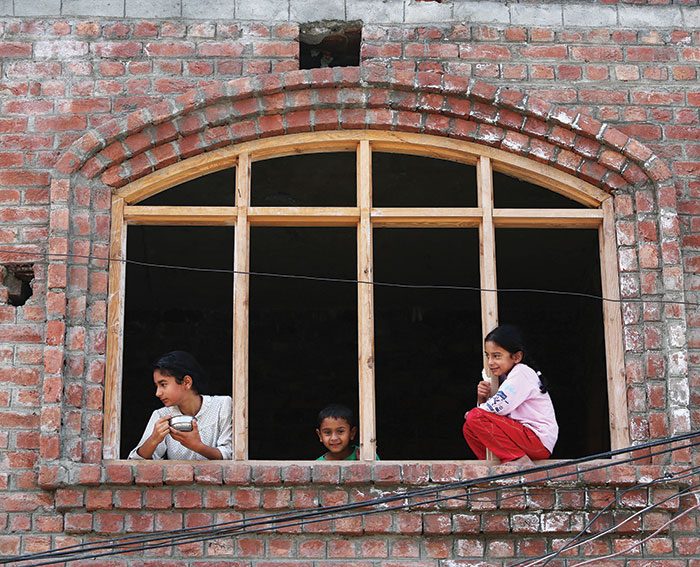
Children peer out of a downtown Srinagar home
However, all Kashmiris have a common hate for a section of Delhi-based TV channels for their jingoistic approach to the issue of Kashmir. “If you close down these channels, Kashmir will be normal,” said an enraged official in the CM’s secretariat. Leaders cutting across party lines said the TV coverage of militant funerals was creating a romantic image of a terrorist. Prime-time debates, they said, were provocative in nature and insulting to the Kashmiris.
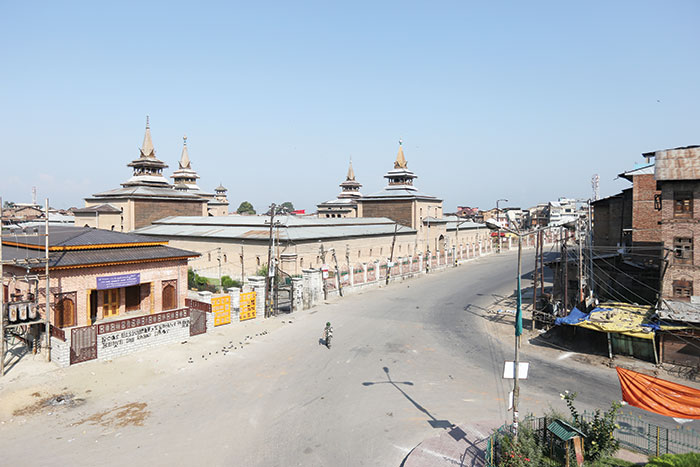
A deserted road near Jamia Masjid in downtown Srinagar
Kashmir’s shutdown is one month old as I write this report. Some people say it would end after August 15 while others fear it may stretch on to September till Eid-ul-Zuha [September 10 or 11] and the onset of the harvest season. Looking from the window of my hotel room the Jhelum looks calm. Its serenity is interrupted by chirping birds hopping on the Chinar branches. I am told that Kashmiris have learnt to live normal lives in seemingly abnormal times – they somehow manage their supply of vegetables, milk and other essentials even amidst long shutdowns. While all resourceful Kashmiris have sent their children out of the Valley, others have to miss their schools and colleges.
Meanwhile, Shakeel, who sells exquisitely embroidered shawls and saris in Srinagar’s Polo View market, has been struggling to get lifesaving drugs for his brother who is suffering from cancer. The drugs, which have been subsidised by the prime minister’s office and supplied by Mumbai’s Tata Memorial hospital, are yet to reach the patient because of the civil curfew.
aasha@governancenow.com
(The story appears as cover in the August 16-31, 2016 issue of Governance Now)

